Detailed Report on Management Accounting Systems and Reporting
VerifiedAdded on 2021/02/22
|23
|6728
|51
Report
AI Summary
This report provides a detailed analysis of management accounting, focusing on its systems, reporting methods, and costing techniques. It begins with an introduction to management accounting and its role in decision-making, using Renishaw Plc as a case study. The report explores various management accounting systems, including cost accounting, inventory management, price optimization, and job costing, highlighting their benefits and applications. It then delves into management accounting reporting methods such as account receivable reports, budget reports, performance reports, and inventory management reports. The report also examines the integration of these systems with organizational processes. Furthermore, it discusses planning tools for budgetary control and compares different approaches to resolving financial problems, emphasizing how management accounting contributes to sustainable success. The report includes a conclusion summarizing the key findings and a list of references.
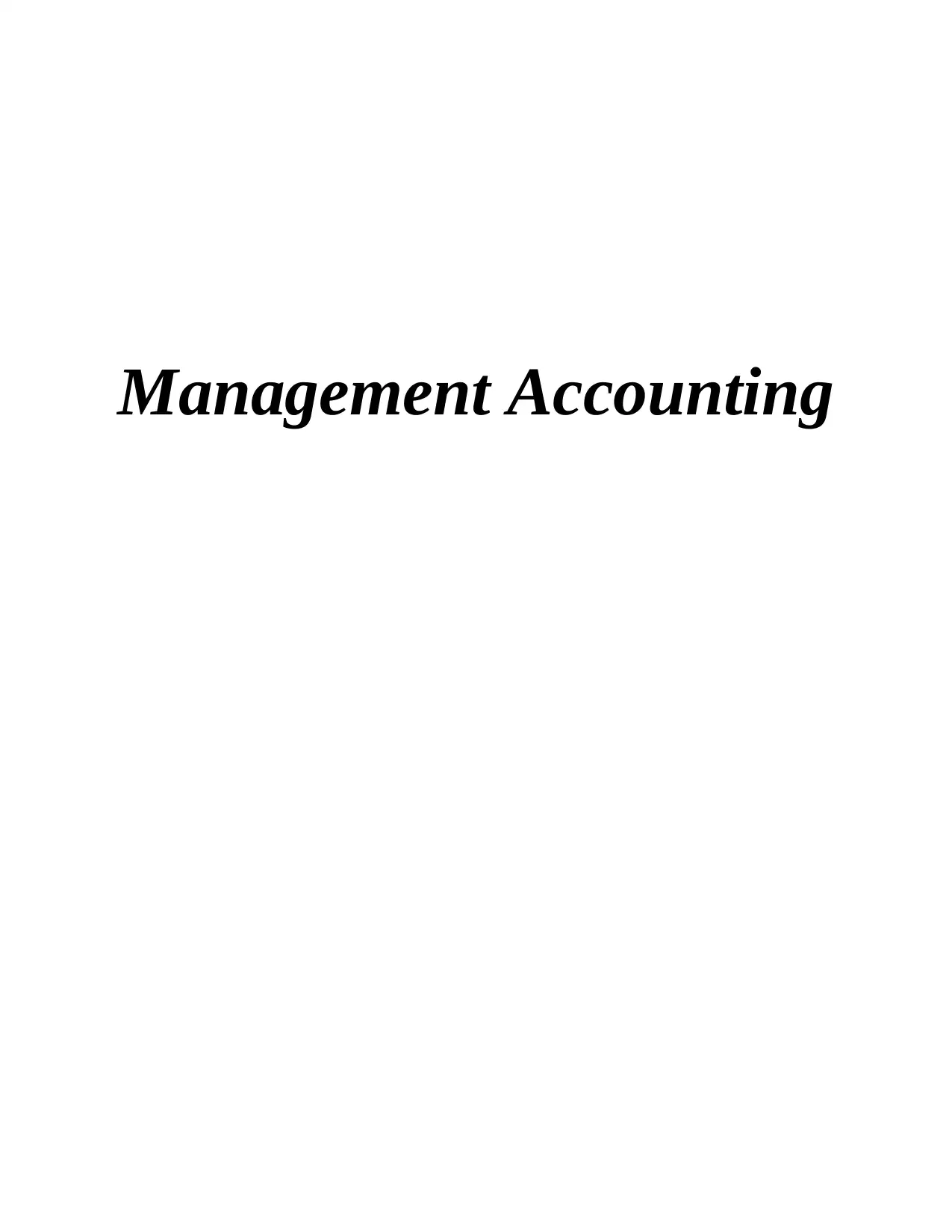
Management Accounting
Paraphrase This Document
Need a fresh take? Get an instant paraphrase of this document with our AI Paraphraser
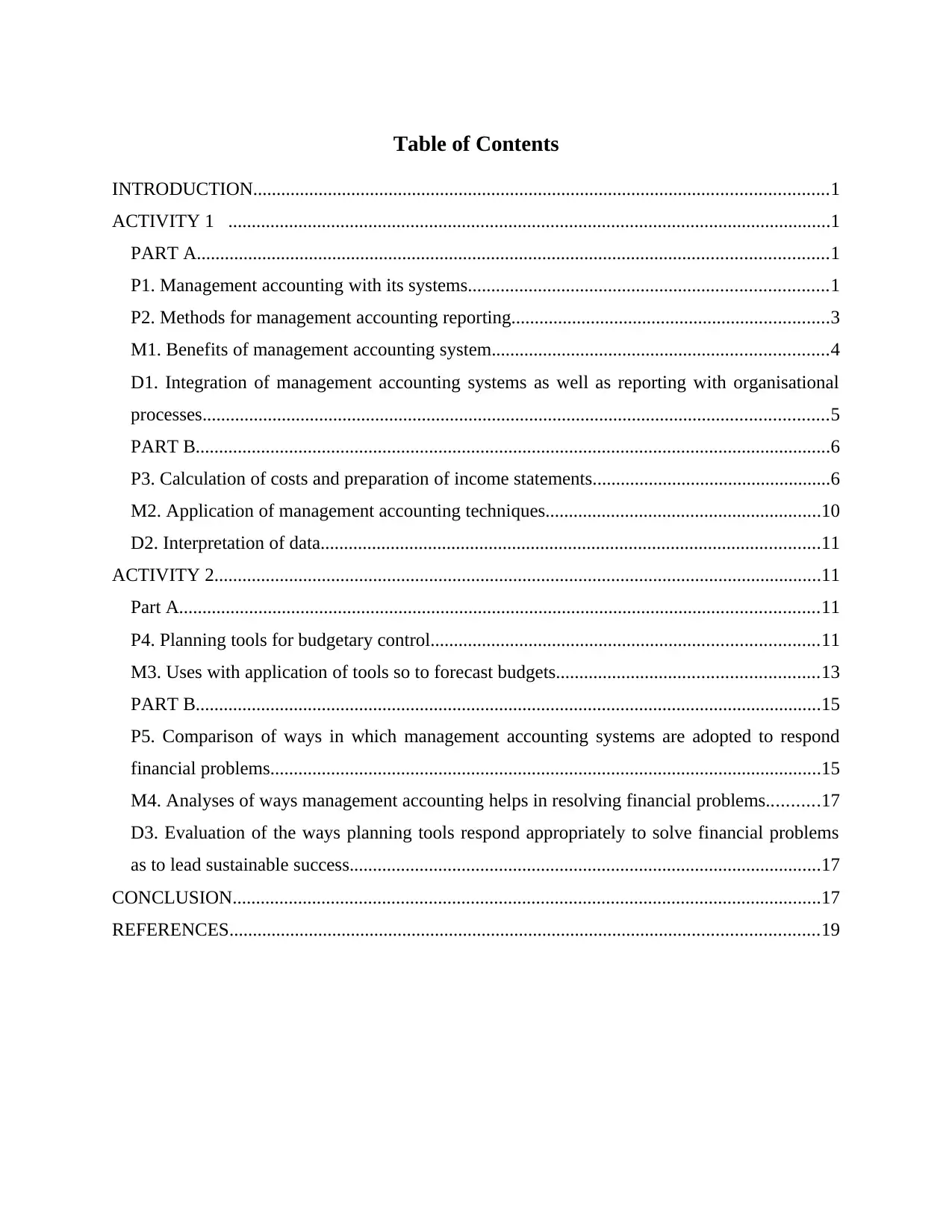
Table of Contents
INTRODUCTION...........................................................................................................................1
ACTIVITY 1 .................................................................................................................................1
PART A.......................................................................................................................................1
P1. Management accounting with its systems.............................................................................1
P2. Methods for management accounting reporting....................................................................3
M1. Benefits of management accounting system........................................................................4
D1. Integration of management accounting systems as well as reporting with organisational
processes......................................................................................................................................5
PART B........................................................................................................................................6
P3. Calculation of costs and preparation of income statements...................................................6
M2. Application of management accounting techniques...........................................................10
D2. Interpretation of data...........................................................................................................11
ACTIVITY 2..................................................................................................................................11
Part A.........................................................................................................................................11
P4. Planning tools for budgetary control...................................................................................11
M3. Uses with application of tools so to forecast budgets........................................................13
PART B......................................................................................................................................15
P5. Comparison of ways in which management accounting systems are adopted to respond
financial problems......................................................................................................................15
M4. Analyses of ways management accounting helps in resolving financial problems...........17
D3. Evaluation of the ways planning tools respond appropriately to solve financial problems
as to lead sustainable success.....................................................................................................17
CONCLUSION..............................................................................................................................17
REFERENCES..............................................................................................................................19
INTRODUCTION...........................................................................................................................1
ACTIVITY 1 .................................................................................................................................1
PART A.......................................................................................................................................1
P1. Management accounting with its systems.............................................................................1
P2. Methods for management accounting reporting....................................................................3
M1. Benefits of management accounting system........................................................................4
D1. Integration of management accounting systems as well as reporting with organisational
processes......................................................................................................................................5
PART B........................................................................................................................................6
P3. Calculation of costs and preparation of income statements...................................................6
M2. Application of management accounting techniques...........................................................10
D2. Interpretation of data...........................................................................................................11
ACTIVITY 2..................................................................................................................................11
Part A.........................................................................................................................................11
P4. Planning tools for budgetary control...................................................................................11
M3. Uses with application of tools so to forecast budgets........................................................13
PART B......................................................................................................................................15
P5. Comparison of ways in which management accounting systems are adopted to respond
financial problems......................................................................................................................15
M4. Analyses of ways management accounting helps in resolving financial problems...........17
D3. Evaluation of the ways planning tools respond appropriately to solve financial problems
as to lead sustainable success.....................................................................................................17
CONCLUSION..............................................................................................................................17
REFERENCES..............................................................................................................................19
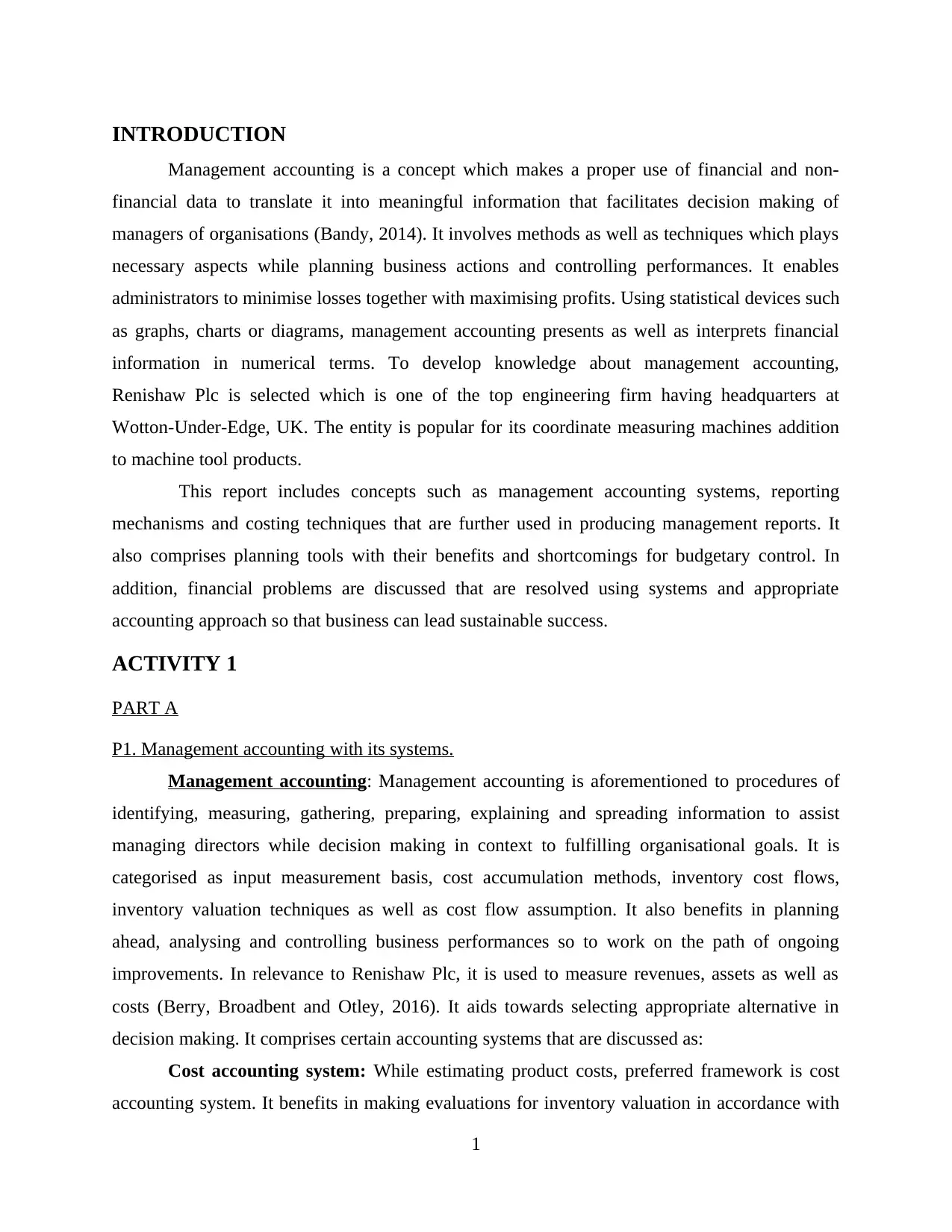
INTRODUCTION
Management accounting is a concept which makes a proper use of financial and non-
financial data to translate it into meaningful information that facilitates decision making of
managers of organisations (Bandy, 2014). It involves methods as well as techniques which plays
necessary aspects while planning business actions and controlling performances. It enables
administrators to minimise losses together with maximising profits. Using statistical devices such
as graphs, charts or diagrams, management accounting presents as well as interprets financial
information in numerical terms. To develop knowledge about management accounting,
Renishaw Plc is selected which is one of the top engineering firm having headquarters at
Wotton-Under-Edge, UK. The entity is popular for its coordinate measuring machines addition
to machine tool products.
This report includes concepts such as management accounting systems, reporting
mechanisms and costing techniques that are further used in producing management reports. It
also comprises planning tools with their benefits and shortcomings for budgetary control. In
addition, financial problems are discussed that are resolved using systems and appropriate
accounting approach so that business can lead sustainable success.
ACTIVITY 1
PART A
P1. Management accounting with its systems.
Management accounting: Management accounting is aforementioned to procedures of
identifying, measuring, gathering, preparing, explaining and spreading information to assist
managing directors while decision making in context to fulfilling organisational goals. It is
categorised as input measurement basis, cost accumulation methods, inventory cost flows,
inventory valuation techniques as well as cost flow assumption. It also benefits in planning
ahead, analysing and controlling business performances so to work on the path of ongoing
improvements. In relevance to Renishaw Plc, it is used to measure revenues, assets as well as
costs (Berry, Broadbent and Otley, 2016). It aids towards selecting appropriate alternative in
decision making. It comprises certain accounting systems that are discussed as:
Cost accounting system: While estimating product costs, preferred framework is cost
accounting system. It benefits in making evaluations for inventory valuation in accordance with
1
Management accounting is a concept which makes a proper use of financial and non-
financial data to translate it into meaningful information that facilitates decision making of
managers of organisations (Bandy, 2014). It involves methods as well as techniques which plays
necessary aspects while planning business actions and controlling performances. It enables
administrators to minimise losses together with maximising profits. Using statistical devices such
as graphs, charts or diagrams, management accounting presents as well as interprets financial
information in numerical terms. To develop knowledge about management accounting,
Renishaw Plc is selected which is one of the top engineering firm having headquarters at
Wotton-Under-Edge, UK. The entity is popular for its coordinate measuring machines addition
to machine tool products.
This report includes concepts such as management accounting systems, reporting
mechanisms and costing techniques that are further used in producing management reports. It
also comprises planning tools with their benefits and shortcomings for budgetary control. In
addition, financial problems are discussed that are resolved using systems and appropriate
accounting approach so that business can lead sustainable success.
ACTIVITY 1
PART A
P1. Management accounting with its systems.
Management accounting: Management accounting is aforementioned to procedures of
identifying, measuring, gathering, preparing, explaining and spreading information to assist
managing directors while decision making in context to fulfilling organisational goals. It is
categorised as input measurement basis, cost accumulation methods, inventory cost flows,
inventory valuation techniques as well as cost flow assumption. It also benefits in planning
ahead, analysing and controlling business performances so to work on the path of ongoing
improvements. In relevance to Renishaw Plc, it is used to measure revenues, assets as well as
costs (Berry, Broadbent and Otley, 2016). It aids towards selecting appropriate alternative in
decision making. It comprises certain accounting systems that are discussed as:
Cost accounting system: While estimating product costs, preferred framework is cost
accounting system. It benefits in making evaluations for inventory valuation in accordance with
1
⊘ This is a preview!⊘
Do you want full access?
Subscribe today to unlock all pages.

Trusted by 1+ million students worldwide
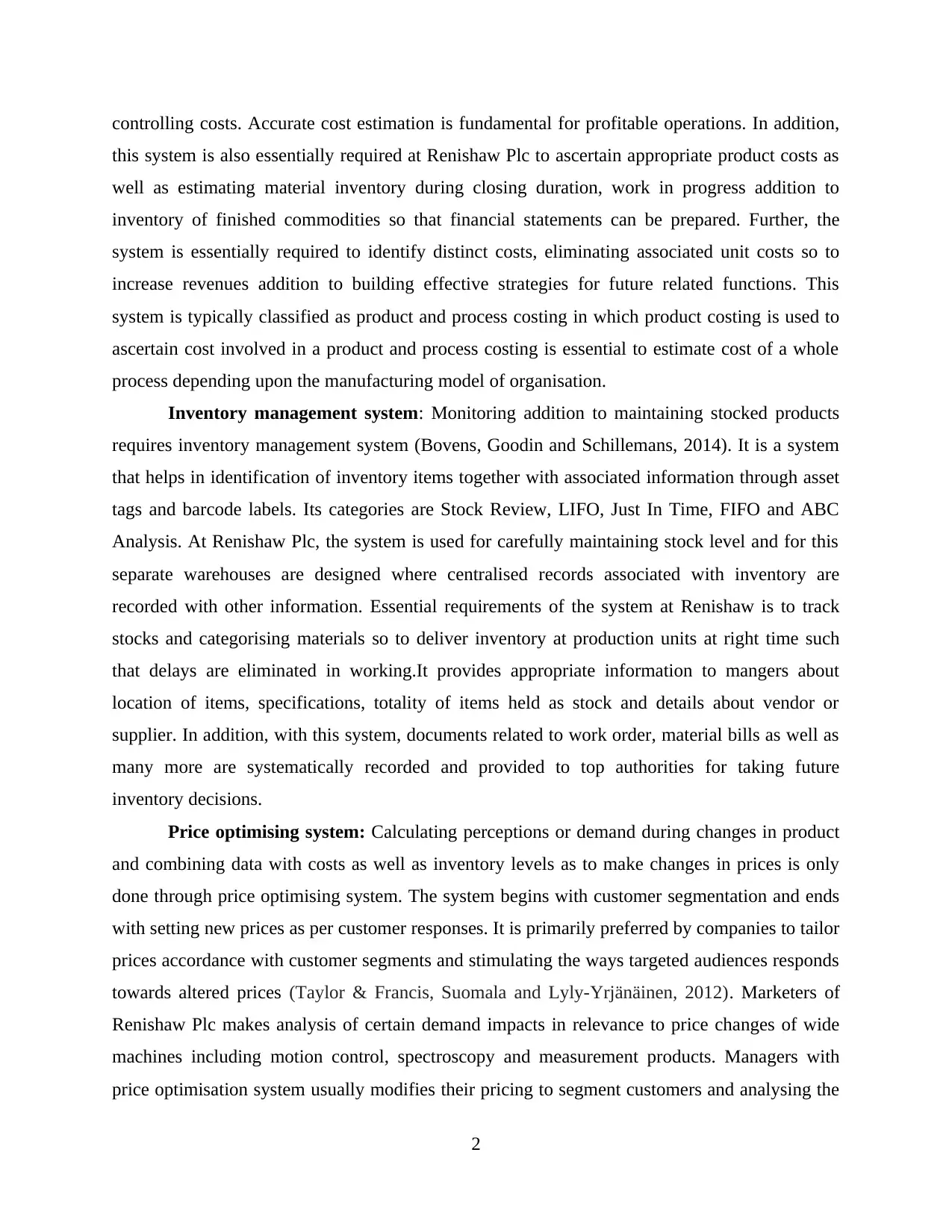
controlling costs. Accurate cost estimation is fundamental for profitable operations. In addition,
this system is also essentially required at Renishaw Plc to ascertain appropriate product costs as
well as estimating material inventory during closing duration, work in progress addition to
inventory of finished commodities so that financial statements can be prepared. Further, the
system is essentially required to identify distinct costs, eliminating associated unit costs so to
increase revenues addition to building effective strategies for future related functions. This
system is typically classified as product and process costing in which product costing is used to
ascertain cost involved in a product and process costing is essential to estimate cost of a whole
process depending upon the manufacturing model of organisation.
Inventory management system: Monitoring addition to maintaining stocked products
requires inventory management system (Bovens, Goodin and Schillemans, 2014). It is a system
that helps in identification of inventory items together with associated information through asset
tags and barcode labels. Its categories are Stock Review, LIFO, Just In Time, FIFO and ABC
Analysis. At Renishaw Plc, the system is used for carefully maintaining stock level and for this
separate warehouses are designed where centralised records associated with inventory are
recorded with other information. Essential requirements of the system at Renishaw is to track
stocks and categorising materials so to deliver inventory at production units at right time such
that delays are eliminated in working.It provides appropriate information to mangers about
location of items, specifications, totality of items held as stock and details about vendor or
supplier. In addition, with this system, documents related to work order, material bills as well as
many more are systematically recorded and provided to top authorities for taking future
inventory decisions.
Price optimising system: Calculating perceptions or demand during changes in product
and combining data with costs as well as inventory levels as to make changes in prices is only
done through price optimising system. The system begins with customer segmentation and ends
with setting new prices as per customer responses. It is primarily preferred by companies to tailor
prices accordance with customer segments and stimulating the ways targeted audiences responds
towards altered prices (Taylor & Francis, Suomala and Lyly-Yrjänäinen, 2012). Marketers of
Renishaw Plc makes analysis of certain demand impacts in relevance to price changes of wide
machines including motion control, spectroscopy and measurement products. Managers with
price optimisation system usually modifies their pricing to segment customers and analysing the
2
this system is also essentially required at Renishaw Plc to ascertain appropriate product costs as
well as estimating material inventory during closing duration, work in progress addition to
inventory of finished commodities so that financial statements can be prepared. Further, the
system is essentially required to identify distinct costs, eliminating associated unit costs so to
increase revenues addition to building effective strategies for future related functions. This
system is typically classified as product and process costing in which product costing is used to
ascertain cost involved in a product and process costing is essential to estimate cost of a whole
process depending upon the manufacturing model of organisation.
Inventory management system: Monitoring addition to maintaining stocked products
requires inventory management system (Bovens, Goodin and Schillemans, 2014). It is a system
that helps in identification of inventory items together with associated information through asset
tags and barcode labels. Its categories are Stock Review, LIFO, Just In Time, FIFO and ABC
Analysis. At Renishaw Plc, the system is used for carefully maintaining stock level and for this
separate warehouses are designed where centralised records associated with inventory are
recorded with other information. Essential requirements of the system at Renishaw is to track
stocks and categorising materials so to deliver inventory at production units at right time such
that delays are eliminated in working.It provides appropriate information to mangers about
location of items, specifications, totality of items held as stock and details about vendor or
supplier. In addition, with this system, documents related to work order, material bills as well as
many more are systematically recorded and provided to top authorities for taking future
inventory decisions.
Price optimising system: Calculating perceptions or demand during changes in product
and combining data with costs as well as inventory levels as to make changes in prices is only
done through price optimising system. The system begins with customer segmentation and ends
with setting new prices as per customer responses. It is primarily preferred by companies to tailor
prices accordance with customer segments and stimulating the ways targeted audiences responds
towards altered prices (Taylor & Francis, Suomala and Lyly-Yrjänäinen, 2012). Marketers of
Renishaw Plc makes analysis of certain demand impacts in relevance to price changes of wide
machines including motion control, spectroscopy and measurement products. Managers with
price optimisation system usually modifies their pricing to segment customers and analysing the
2
Paraphrase This Document
Need a fresh take? Get an instant paraphrase of this document with our AI Paraphraser
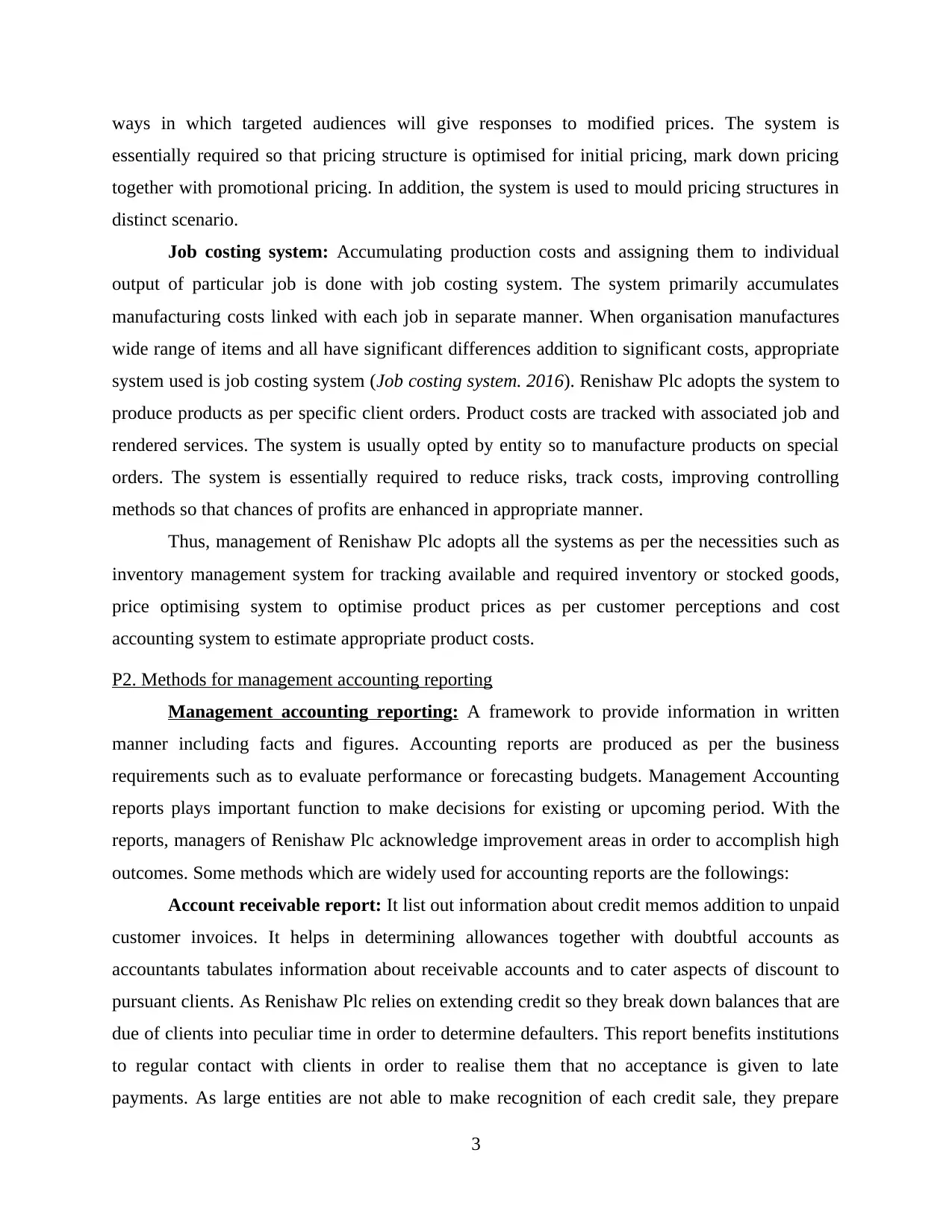
ways in which targeted audiences will give responses to modified prices. The system is
essentially required so that pricing structure is optimised for initial pricing, mark down pricing
together with promotional pricing. In addition, the system is used to mould pricing structures in
distinct scenario.
Job costing system: Accumulating production costs and assigning them to individual
output of particular job is done with job costing system. The system primarily accumulates
manufacturing costs linked with each job in separate manner. When organisation manufactures
wide range of items and all have significant differences addition to significant costs, appropriate
system used is job costing system (Job costing system. 2016). Renishaw Plc adopts the system to
produce products as per specific client orders. Product costs are tracked with associated job and
rendered services. The system is usually opted by entity so to manufacture products on special
orders. The system is essentially required to reduce risks, track costs, improving controlling
methods so that chances of profits are enhanced in appropriate manner.
Thus, management of Renishaw Plc adopts all the systems as per the necessities such as
inventory management system for tracking available and required inventory or stocked goods,
price optimising system to optimise product prices as per customer perceptions and cost
accounting system to estimate appropriate product costs.
P2. Methods for management accounting reporting
Management accounting reporting: A framework to provide information in written
manner including facts and figures. Accounting reports are produced as per the business
requirements such as to evaluate performance or forecasting budgets. Management Accounting
reports plays important function to make decisions for existing or upcoming period. With the
reports, managers of Renishaw Plc acknowledge improvement areas in order to accomplish high
outcomes. Some methods which are widely used for accounting reports are the followings:
Account receivable report: It list out information about credit memos addition to unpaid
customer invoices. It helps in determining allowances together with doubtful accounts as
accountants tabulates information about receivable accounts and to cater aspects of discount to
pursuant clients. As Renishaw Plc relies on extending credit so they break down balances that are
due of clients into peculiar time in order to determine defaulters. This report benefits institutions
to regular contact with clients in order to realise them that no acceptance is given to late
payments. As large entities are not able to make recognition of each credit sale, they prepare
3
essentially required so that pricing structure is optimised for initial pricing, mark down pricing
together with promotional pricing. In addition, the system is used to mould pricing structures in
distinct scenario.
Job costing system: Accumulating production costs and assigning them to individual
output of particular job is done with job costing system. The system primarily accumulates
manufacturing costs linked with each job in separate manner. When organisation manufactures
wide range of items and all have significant differences addition to significant costs, appropriate
system used is job costing system (Job costing system. 2016). Renishaw Plc adopts the system to
produce products as per specific client orders. Product costs are tracked with associated job and
rendered services. The system is usually opted by entity so to manufacture products on special
orders. The system is essentially required to reduce risks, track costs, improving controlling
methods so that chances of profits are enhanced in appropriate manner.
Thus, management of Renishaw Plc adopts all the systems as per the necessities such as
inventory management system for tracking available and required inventory or stocked goods,
price optimising system to optimise product prices as per customer perceptions and cost
accounting system to estimate appropriate product costs.
P2. Methods for management accounting reporting
Management accounting reporting: A framework to provide information in written
manner including facts and figures. Accounting reports are produced as per the business
requirements such as to evaluate performance or forecasting budgets. Management Accounting
reports plays important function to make decisions for existing or upcoming period. With the
reports, managers of Renishaw Plc acknowledge improvement areas in order to accomplish high
outcomes. Some methods which are widely used for accounting reports are the followings:
Account receivable report: It list out information about credit memos addition to unpaid
customer invoices. It helps in determining allowances together with doubtful accounts as
accountants tabulates information about receivable accounts and to cater aspects of discount to
pursuant clients. As Renishaw Plc relies on extending credit so they break down balances that are
due of clients into peculiar time in order to determine defaulters. This report benefits institutions
to regular contact with clients in order to realise them that no acceptance is given to late
payments. As large entities are not able to make recognition of each credit sale, they prepare
3
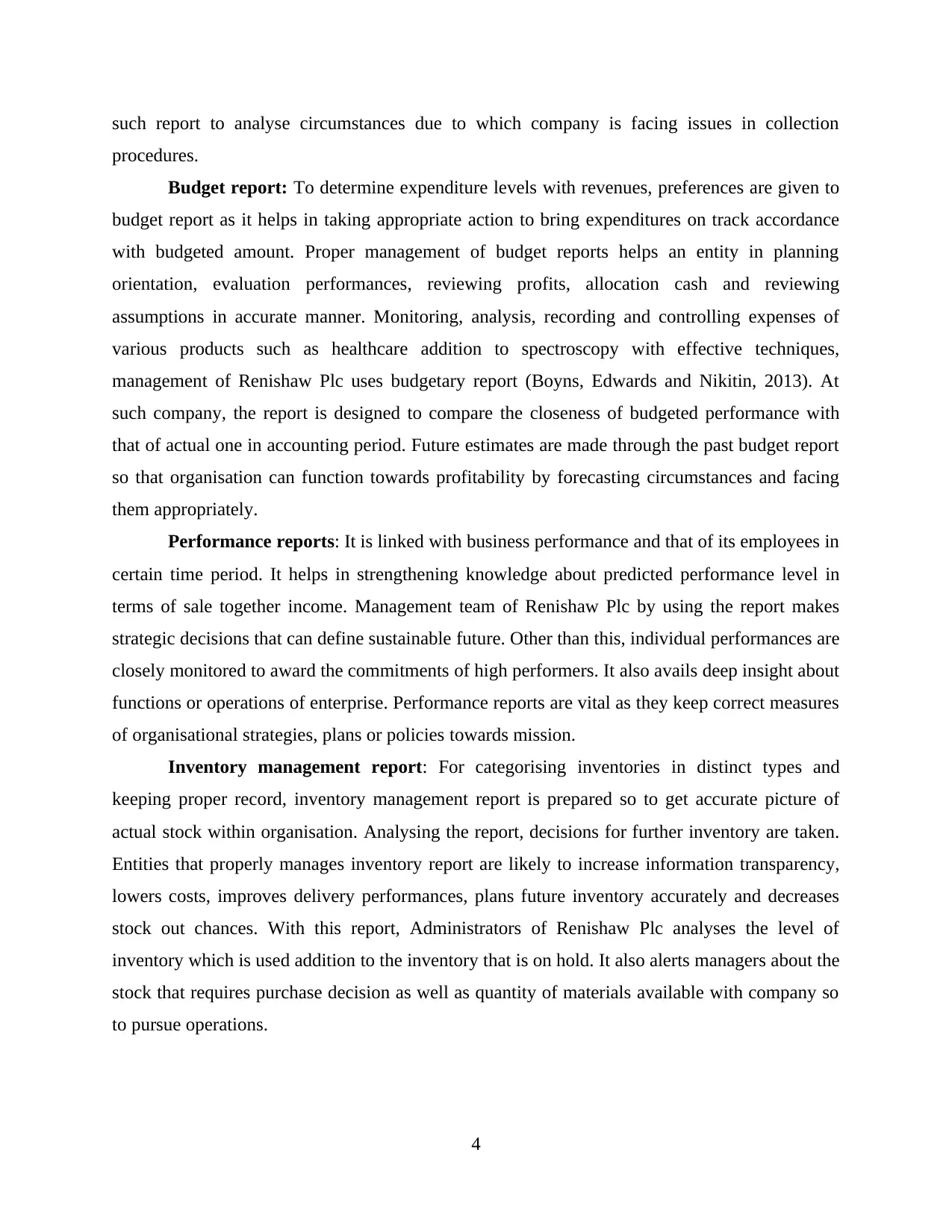
such report to analyse circumstances due to which company is facing issues in collection
procedures.
Budget report: To determine expenditure levels with revenues, preferences are given to
budget report as it helps in taking appropriate action to bring expenditures on track accordance
with budgeted amount. Proper management of budget reports helps an entity in planning
orientation, evaluation performances, reviewing profits, allocation cash and reviewing
assumptions in accurate manner. Monitoring, analysis, recording and controlling expenses of
various products such as healthcare addition to spectroscopy with effective techniques,
management of Renishaw Plc uses budgetary report (Boyns, Edwards and Nikitin, 2013). At
such company, the report is designed to compare the closeness of budgeted performance with
that of actual one in accounting period. Future estimates are made through the past budget report
so that organisation can function towards profitability by forecasting circumstances and facing
them appropriately.
Performance reports: It is linked with business performance and that of its employees in
certain time period. It helps in strengthening knowledge about predicted performance level in
terms of sale together income. Management team of Renishaw Plc by using the report makes
strategic decisions that can define sustainable future. Other than this, individual performances are
closely monitored to award the commitments of high performers. It also avails deep insight about
functions or operations of enterprise. Performance reports are vital as they keep correct measures
of organisational strategies, plans or policies towards mission.
Inventory management report: For categorising inventories in distinct types and
keeping proper record, inventory management report is prepared so to get accurate picture of
actual stock within organisation. Analysing the report, decisions for further inventory are taken.
Entities that properly manages inventory report are likely to increase information transparency,
lowers costs, improves delivery performances, plans future inventory accurately and decreases
stock out chances. With this report, Administrators of Renishaw Plc analyses the level of
inventory which is used addition to the inventory that is on hold. It also alerts managers about the
stock that requires purchase decision as well as quantity of materials available with company so
to pursue operations.
4
procedures.
Budget report: To determine expenditure levels with revenues, preferences are given to
budget report as it helps in taking appropriate action to bring expenditures on track accordance
with budgeted amount. Proper management of budget reports helps an entity in planning
orientation, evaluation performances, reviewing profits, allocation cash and reviewing
assumptions in accurate manner. Monitoring, analysis, recording and controlling expenses of
various products such as healthcare addition to spectroscopy with effective techniques,
management of Renishaw Plc uses budgetary report (Boyns, Edwards and Nikitin, 2013). At
such company, the report is designed to compare the closeness of budgeted performance with
that of actual one in accounting period. Future estimates are made through the past budget report
so that organisation can function towards profitability by forecasting circumstances and facing
them appropriately.
Performance reports: It is linked with business performance and that of its employees in
certain time period. It helps in strengthening knowledge about predicted performance level in
terms of sale together income. Management team of Renishaw Plc by using the report makes
strategic decisions that can define sustainable future. Other than this, individual performances are
closely monitored to award the commitments of high performers. It also avails deep insight about
functions or operations of enterprise. Performance reports are vital as they keep correct measures
of organisational strategies, plans or policies towards mission.
Inventory management report: For categorising inventories in distinct types and
keeping proper record, inventory management report is prepared so to get accurate picture of
actual stock within organisation. Analysing the report, decisions for further inventory are taken.
Entities that properly manages inventory report are likely to increase information transparency,
lowers costs, improves delivery performances, plans future inventory accurately and decreases
stock out chances. With this report, Administrators of Renishaw Plc analyses the level of
inventory which is used addition to the inventory that is on hold. It also alerts managers about the
stock that requires purchase decision as well as quantity of materials available with company so
to pursue operations.
4
⊘ This is a preview!⊘
Do you want full access?
Subscribe today to unlock all pages.

Trusted by 1+ million students worldwide
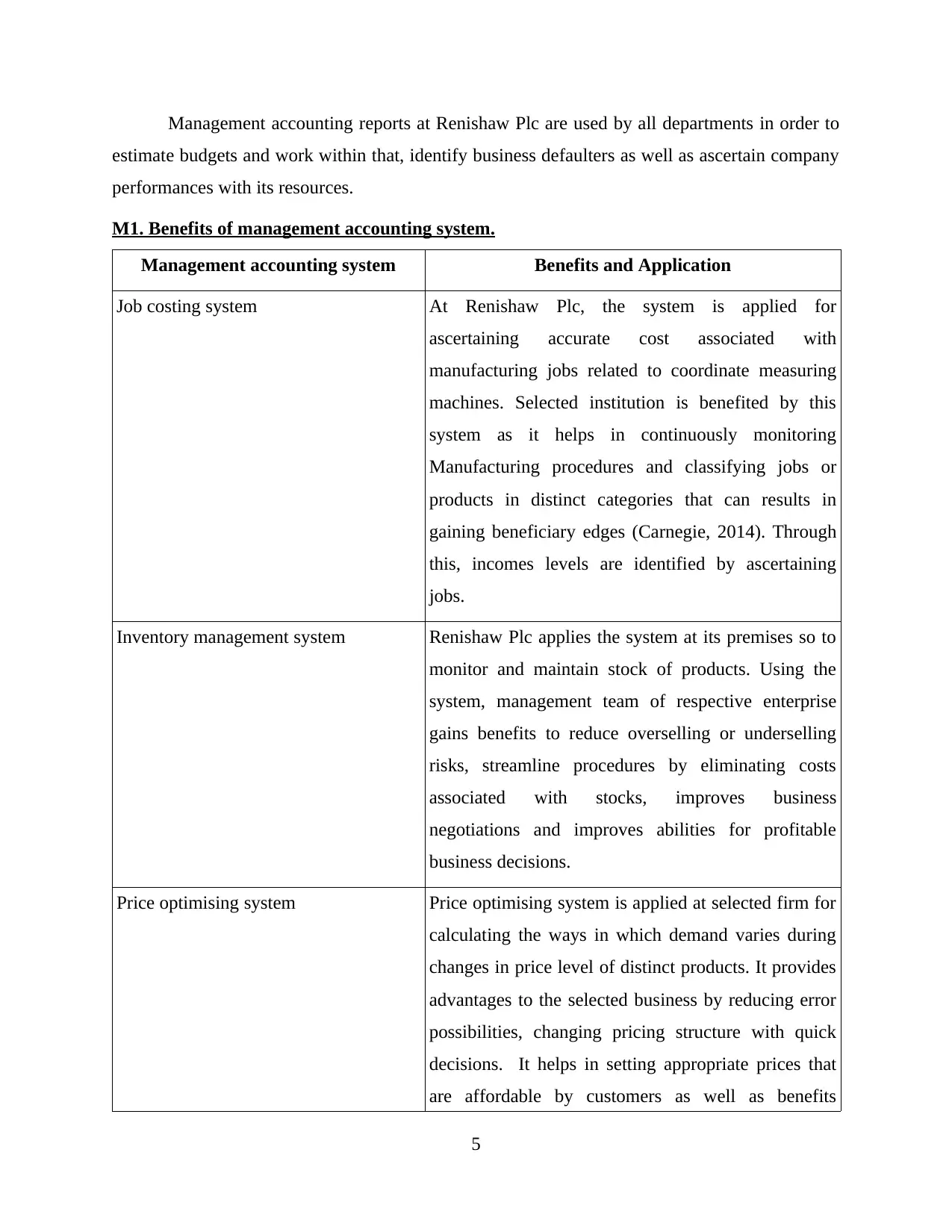
Management accounting reports at Renishaw Plc are used by all departments in order to
estimate budgets and work within that, identify business defaulters as well as ascertain company
performances with its resources.
M1. Benefits of management accounting system.
Management accounting system Benefits and Application
Job costing system At Renishaw Plc, the system is applied for
ascertaining accurate cost associated with
manufacturing jobs related to coordinate measuring
machines. Selected institution is benefited by this
system as it helps in continuously monitoring
Manufacturing procedures and classifying jobs or
products in distinct categories that can results in
gaining beneficiary edges (Carnegie, 2014). Through
this, incomes levels are identified by ascertaining
jobs.
Inventory management system Renishaw Plc applies the system at its premises so to
monitor and maintain stock of products. Using the
system, management team of respective enterprise
gains benefits to reduce overselling or underselling
risks, streamline procedures by eliminating costs
associated with stocks, improves business
negotiations and improves abilities for profitable
business decisions.
Price optimising system Price optimising system is applied at selected firm for
calculating the ways in which demand varies during
changes in price level of distinct products. It provides
advantages to the selected business by reducing error
possibilities, changing pricing structure with quick
decisions. It helps in setting appropriate prices that
are affordable by customers as well as benefits
5
estimate budgets and work within that, identify business defaulters as well as ascertain company
performances with its resources.
M1. Benefits of management accounting system.
Management accounting system Benefits and Application
Job costing system At Renishaw Plc, the system is applied for
ascertaining accurate cost associated with
manufacturing jobs related to coordinate measuring
machines. Selected institution is benefited by this
system as it helps in continuously monitoring
Manufacturing procedures and classifying jobs or
products in distinct categories that can results in
gaining beneficiary edges (Carnegie, 2014). Through
this, incomes levels are identified by ascertaining
jobs.
Inventory management system Renishaw Plc applies the system at its premises so to
monitor and maintain stock of products. Using the
system, management team of respective enterprise
gains benefits to reduce overselling or underselling
risks, streamline procedures by eliminating costs
associated with stocks, improves business
negotiations and improves abilities for profitable
business decisions.
Price optimising system Price optimising system is applied at selected firm for
calculating the ways in which demand varies during
changes in price level of distinct products. It provides
advantages to the selected business by reducing error
possibilities, changing pricing structure with quick
decisions. It helps in setting appropriate prices that
are affordable by customers as well as benefits
5
Paraphrase This Document
Need a fresh take? Get an instant paraphrase of this document with our AI Paraphraser
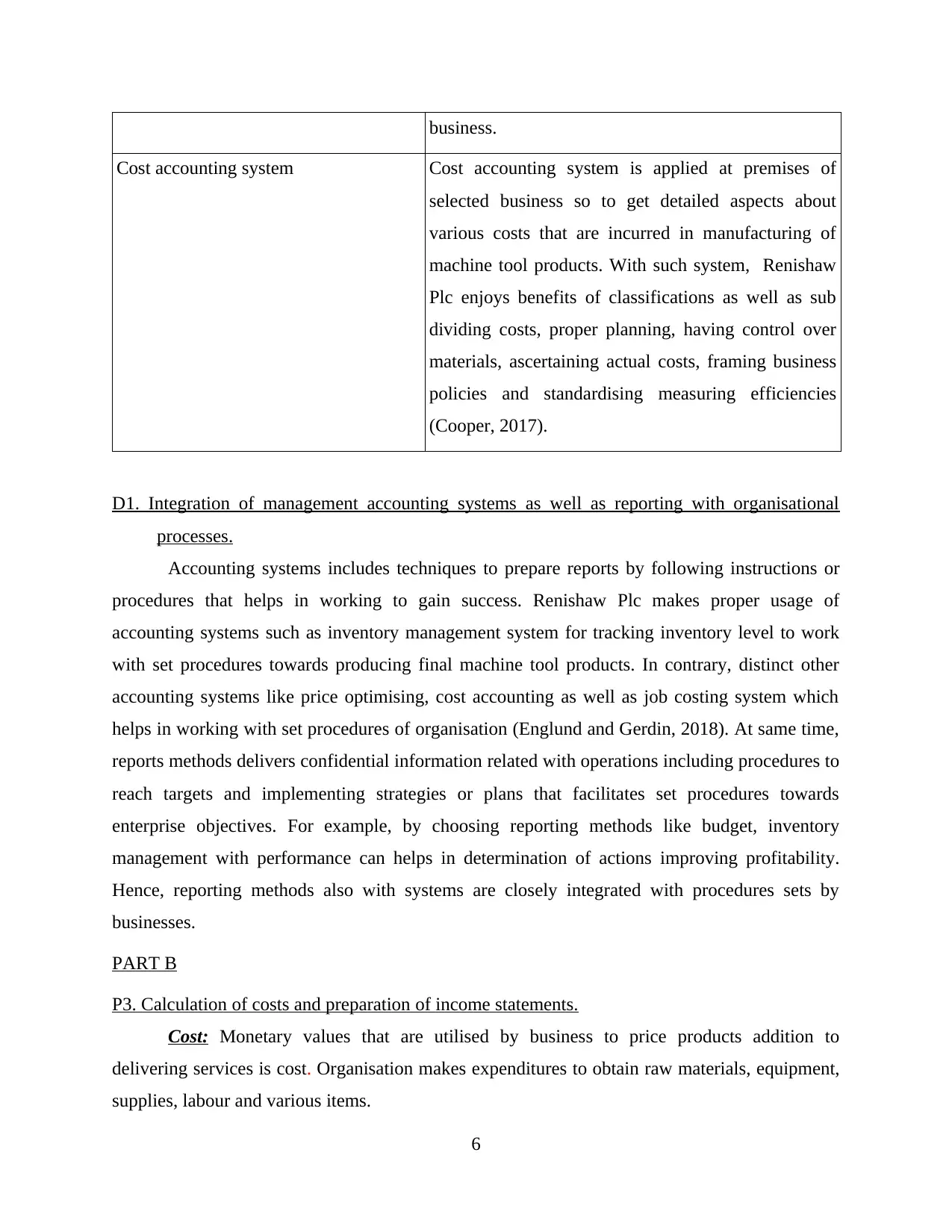
business.
Cost accounting system Cost accounting system is applied at premises of
selected business so to get detailed aspects about
various costs that are incurred in manufacturing of
machine tool products. With such system, Renishaw
Plc enjoys benefits of classifications as well as sub
dividing costs, proper planning, having control over
materials, ascertaining actual costs, framing business
policies and standardising measuring efficiencies
(Cooper, 2017).
D1. Integration of management accounting systems as well as reporting with organisational
processes.
Accounting systems includes techniques to prepare reports by following instructions or
procedures that helps in working to gain success. Renishaw Plc makes proper usage of
accounting systems such as inventory management system for tracking inventory level to work
with set procedures towards producing final machine tool products. In contrary, distinct other
accounting systems like price optimising, cost accounting as well as job costing system which
helps in working with set procedures of organisation (Englund and Gerdin, 2018). At same time,
reports methods delivers confidential information related with operations including procedures to
reach targets and implementing strategies or plans that facilitates set procedures towards
enterprise objectives. For example, by choosing reporting methods like budget, inventory
management with performance can helps in determination of actions improving profitability.
Hence, reporting methods also with systems are closely integrated with procedures sets by
businesses.
PART B
P3. Calculation of costs and preparation of income statements.
Cost: Monetary values that are utilised by business to price products addition to
delivering services is cost. Organisation makes expenditures to obtain raw materials, equipment,
supplies, labour and various items.
6
Cost accounting system Cost accounting system is applied at premises of
selected business so to get detailed aspects about
various costs that are incurred in manufacturing of
machine tool products. With such system, Renishaw
Plc enjoys benefits of classifications as well as sub
dividing costs, proper planning, having control over
materials, ascertaining actual costs, framing business
policies and standardising measuring efficiencies
(Cooper, 2017).
D1. Integration of management accounting systems as well as reporting with organisational
processes.
Accounting systems includes techniques to prepare reports by following instructions or
procedures that helps in working to gain success. Renishaw Plc makes proper usage of
accounting systems such as inventory management system for tracking inventory level to work
with set procedures towards producing final machine tool products. In contrary, distinct other
accounting systems like price optimising, cost accounting as well as job costing system which
helps in working with set procedures of organisation (Englund and Gerdin, 2018). At same time,
reports methods delivers confidential information related with operations including procedures to
reach targets and implementing strategies or plans that facilitates set procedures towards
enterprise objectives. For example, by choosing reporting methods like budget, inventory
management with performance can helps in determination of actions improving profitability.
Hence, reporting methods also with systems are closely integrated with procedures sets by
businesses.
PART B
P3. Calculation of costs and preparation of income statements.
Cost: Monetary values that are utilised by business to price products addition to
delivering services is cost. Organisation makes expenditures to obtain raw materials, equipment,
supplies, labour and various items.
6
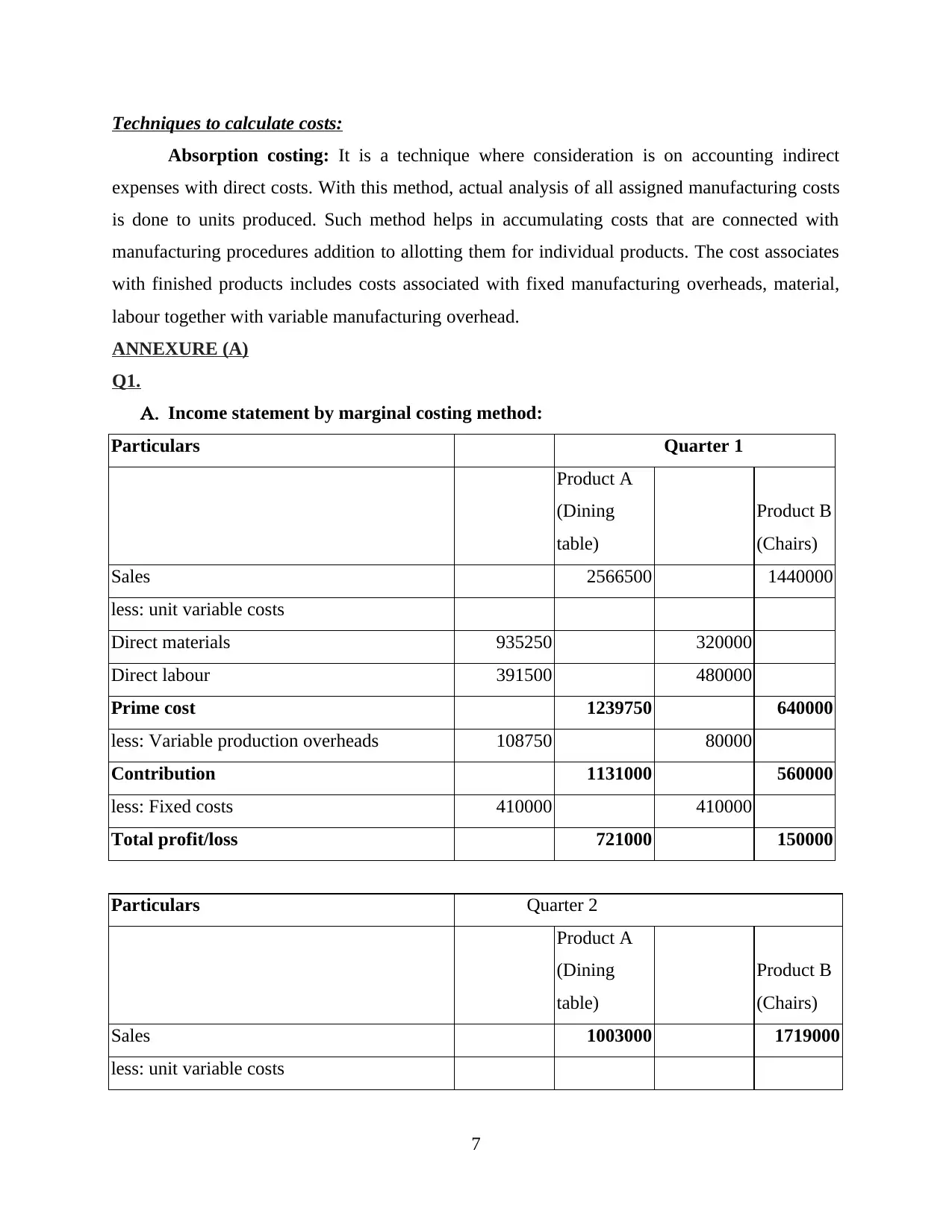
Techniques to calculate costs:
Absorption costing: It is a technique where consideration is on accounting indirect
expenses with direct costs. With this method, actual analysis of all assigned manufacturing costs
is done to units produced. Such method helps in accumulating costs that are connected with
manufacturing procedures addition to allotting them for individual products. The cost associates
with finished products includes costs associated with fixed manufacturing overheads, material,
labour together with variable manufacturing overhead.
ANNEXURE (A)
Q1.
A. Income statement by marginal costing method:
Particulars Quarter 1
Product A
(Dining
table)
Product B
(Chairs)
Sales 2566500 1440000
less: unit variable costs
Direct materials 935250 320000
Direct labour 391500 480000
Prime cost 1239750 640000
less: Variable production overheads 108750 80000
Contribution 1131000 560000
less: Fixed costs 410000 410000
Total profit/loss 721000 150000
Particulars Quarter 2
Product A
(Dining
table)
Product B
(Chairs)
Sales 1003000 1719000
less: unit variable costs
7
Absorption costing: It is a technique where consideration is on accounting indirect
expenses with direct costs. With this method, actual analysis of all assigned manufacturing costs
is done to units produced. Such method helps in accumulating costs that are connected with
manufacturing procedures addition to allotting them for individual products. The cost associates
with finished products includes costs associated with fixed manufacturing overheads, material,
labour together with variable manufacturing overhead.
ANNEXURE (A)
Q1.
A. Income statement by marginal costing method:
Particulars Quarter 1
Product A
(Dining
table)
Product B
(Chairs)
Sales 2566500 1440000
less: unit variable costs
Direct materials 935250 320000
Direct labour 391500 480000
Prime cost 1239750 640000
less: Variable production overheads 108750 80000
Contribution 1131000 560000
less: Fixed costs 410000 410000
Total profit/loss 721000 150000
Particulars Quarter 2
Product A
(Dining
table)
Product B
(Chairs)
Sales 1003000 1719000
less: unit variable costs
7
⊘ This is a preview!⊘
Do you want full access?
Subscribe today to unlock all pages.

Trusted by 1+ million students worldwide
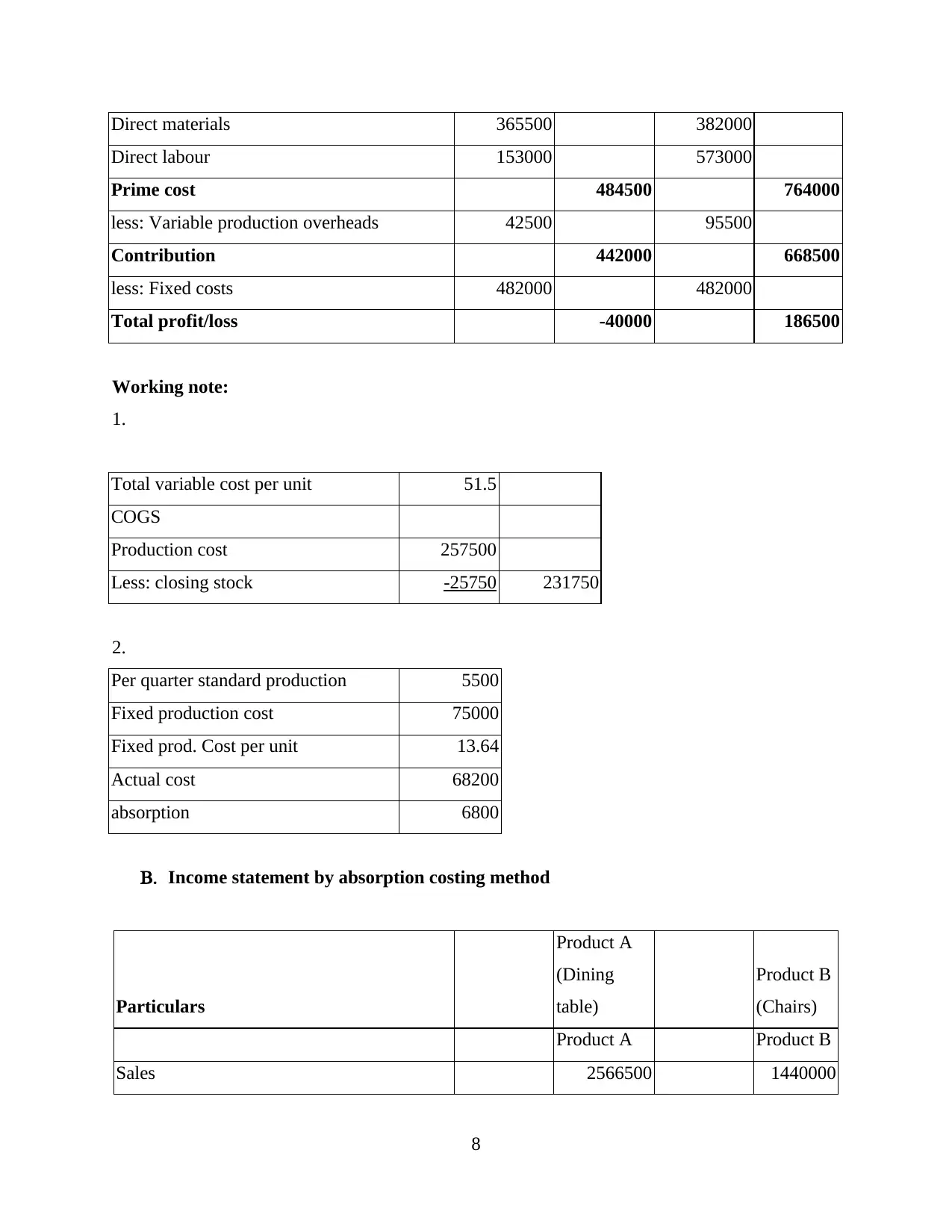
Direct materials 365500 382000
Direct labour 153000 573000
Prime cost 484500 764000
less: Variable production overheads 42500 95500
Contribution 442000 668500
less: Fixed costs 482000 482000
Total profit/loss -40000 186500
Working note:
1.
Total variable cost per unit 51.5
COGS
Production cost 257500
Less: closing stock -25750 231750
2.
Per quarter standard production 5500
Fixed production cost 75000
Fixed prod. Cost per unit 13.64
Actual cost 68200
absorption 6800
B. Income statement by absorption costing method
Particulars
Product A
(Dining
table)
Product B
(Chairs)
Product A Product B
Sales 2566500 1440000
8
Direct labour 153000 573000
Prime cost 484500 764000
less: Variable production overheads 42500 95500
Contribution 442000 668500
less: Fixed costs 482000 482000
Total profit/loss -40000 186500
Working note:
1.
Total variable cost per unit 51.5
COGS
Production cost 257500
Less: closing stock -25750 231750
2.
Per quarter standard production 5500
Fixed production cost 75000
Fixed prod. Cost per unit 13.64
Actual cost 68200
absorption 6800
B. Income statement by absorption costing method
Particulars
Product A
(Dining
table)
Product B
(Chairs)
Product A Product B
Sales 2566500 1440000
8
Paraphrase This Document
Need a fresh take? Get an instant paraphrase of this document with our AI Paraphraser
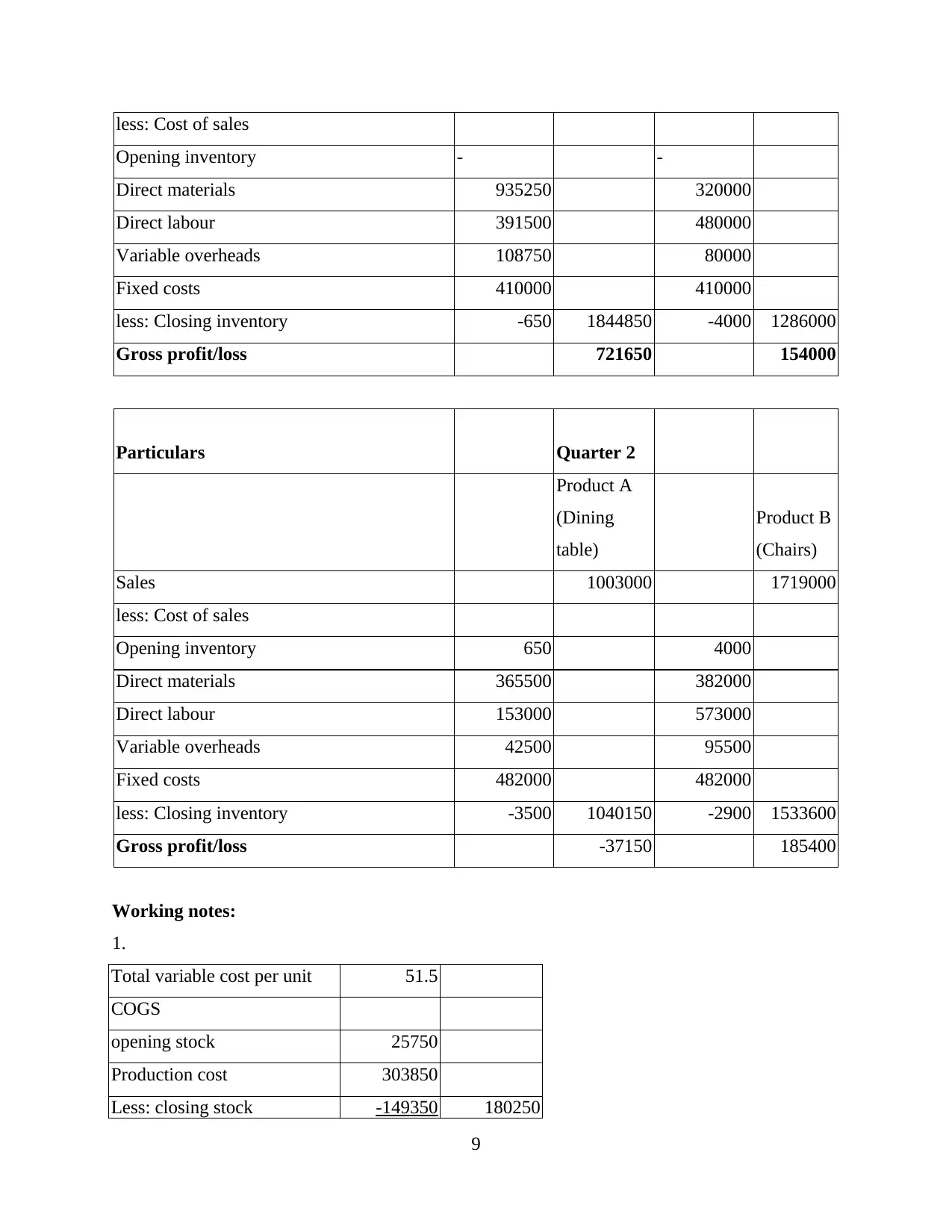
less: Cost of sales
Opening inventory - -
Direct materials 935250 320000
Direct labour 391500 480000
Variable overheads 108750 80000
Fixed costs 410000 410000
less: Closing inventory -650 1844850 -4000 1286000
Gross profit/loss 721650 154000
Particulars Quarter 2
Product A
(Dining
table)
Product B
(Chairs)
Sales 1003000 1719000
less: Cost of sales
Opening inventory 650 4000
Direct materials 365500 382000
Direct labour 153000 573000
Variable overheads 42500 95500
Fixed costs 482000 482000
less: Closing inventory -3500 1040150 -2900 1533600
Gross profit/loss -37150 185400
Working notes:
1.
Total variable cost per unit 51.5
COGS
opening stock 25750
Production cost 303850
Less: closing stock -149350 180250
9
Opening inventory - -
Direct materials 935250 320000
Direct labour 391500 480000
Variable overheads 108750 80000
Fixed costs 410000 410000
less: Closing inventory -650 1844850 -4000 1286000
Gross profit/loss 721650 154000
Particulars Quarter 2
Product A
(Dining
table)
Product B
(Chairs)
Sales 1003000 1719000
less: Cost of sales
Opening inventory 650 4000
Direct materials 365500 382000
Direct labour 153000 573000
Variable overheads 42500 95500
Fixed costs 482000 482000
less: Closing inventory -3500 1040150 -2900 1533600
Gross profit/loss -37150 185400
Working notes:
1.
Total variable cost per unit 51.5
COGS
opening stock 25750
Production cost 303850
Less: closing stock -149350 180250
9
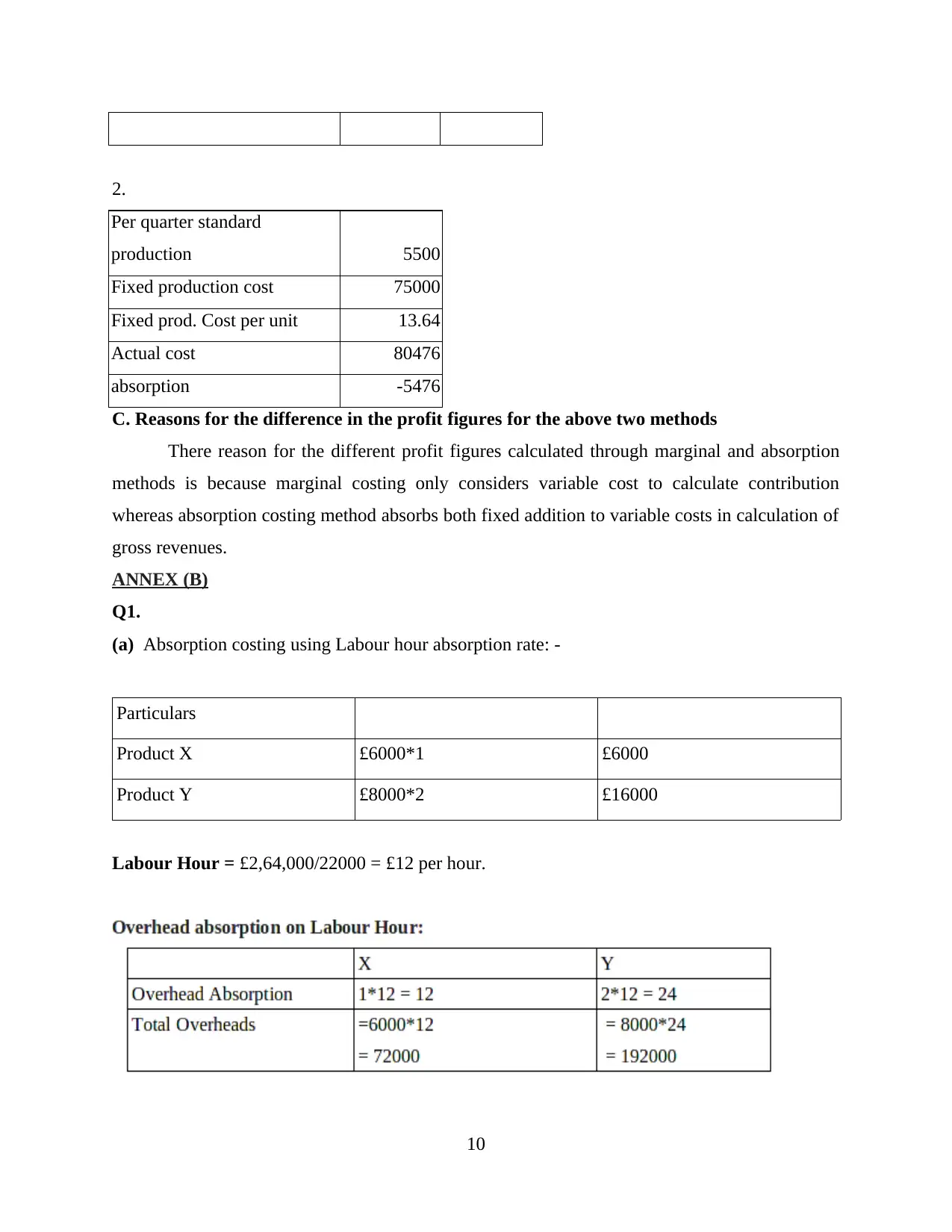
2.
Per quarter standard
production 5500
Fixed production cost 75000
Fixed prod. Cost per unit 13.64
Actual cost 80476
absorption -5476
C. Reasons for the difference in the profit figures for the above two methods
There reason for the different profit figures calculated through marginal and absorption
methods is because marginal costing only considers variable cost to calculate contribution
whereas absorption costing method absorbs both fixed addition to variable costs in calculation of
gross revenues.
ANNEX (B)
Q1.
(a) Absorption costing using Labour hour absorption rate: -
Particulars
Product X £6000*1 £6000
Product Y £8000*2 £16000
Labour Hour = £2,64,000/22000 = £12 per hour.
10
Per quarter standard
production 5500
Fixed production cost 75000
Fixed prod. Cost per unit 13.64
Actual cost 80476
absorption -5476
C. Reasons for the difference in the profit figures for the above two methods
There reason for the different profit figures calculated through marginal and absorption
methods is because marginal costing only considers variable cost to calculate contribution
whereas absorption costing method absorbs both fixed addition to variable costs in calculation of
gross revenues.
ANNEX (B)
Q1.
(a) Absorption costing using Labour hour absorption rate: -
Particulars
Product X £6000*1 £6000
Product Y £8000*2 £16000
Labour Hour = £2,64,000/22000 = £12 per hour.
10
⊘ This is a preview!⊘
Do you want full access?
Subscribe today to unlock all pages.

Trusted by 1+ million students worldwide
1 out of 23
Related Documents
Your All-in-One AI-Powered Toolkit for Academic Success.
+13062052269
info@desklib.com
Available 24*7 on WhatsApp / Email
![[object Object]](/_next/static/media/star-bottom.7253800d.svg)
Unlock your academic potential
Copyright © 2020–2025 A2Z Services. All Rights Reserved. Developed and managed by ZUCOL.





